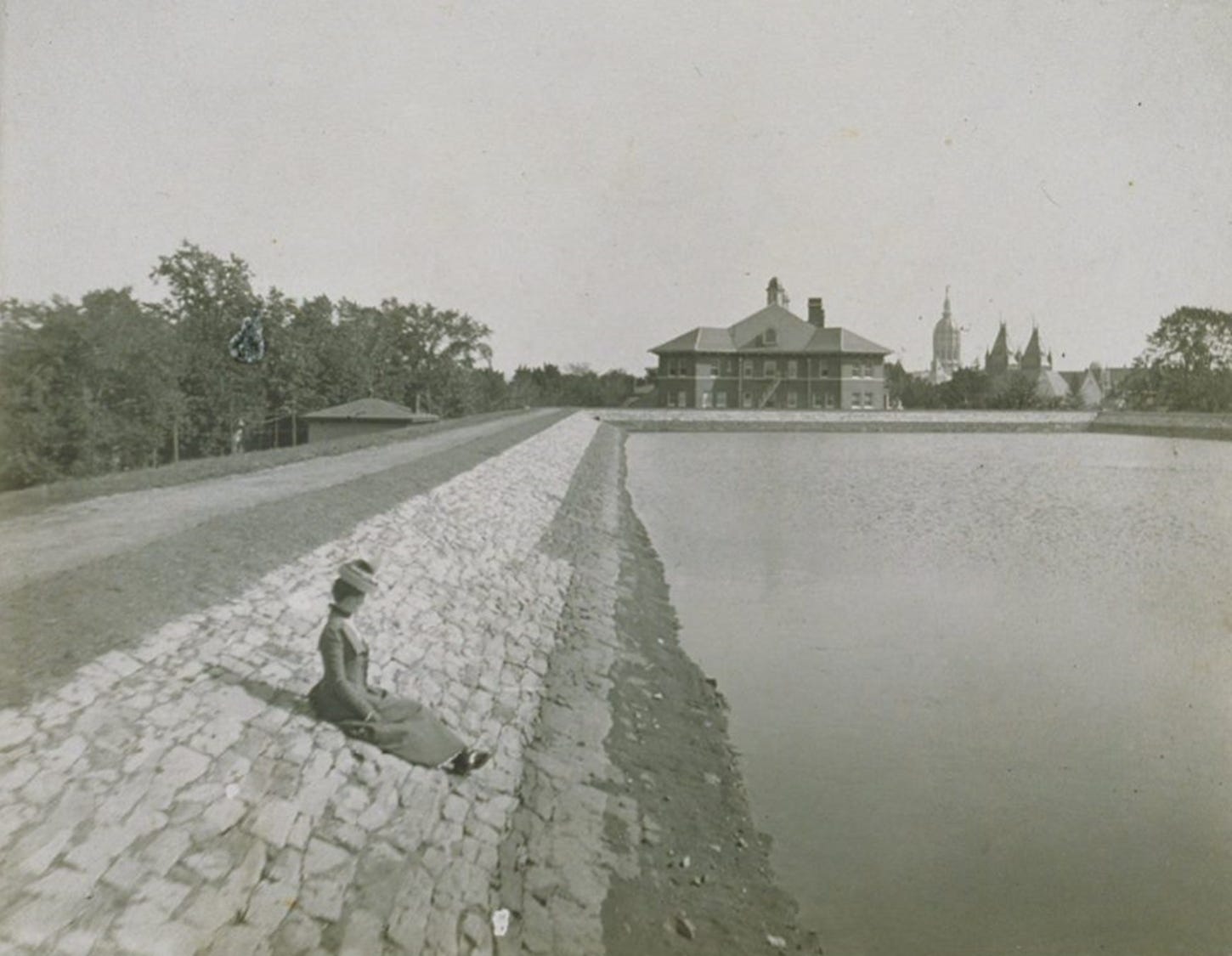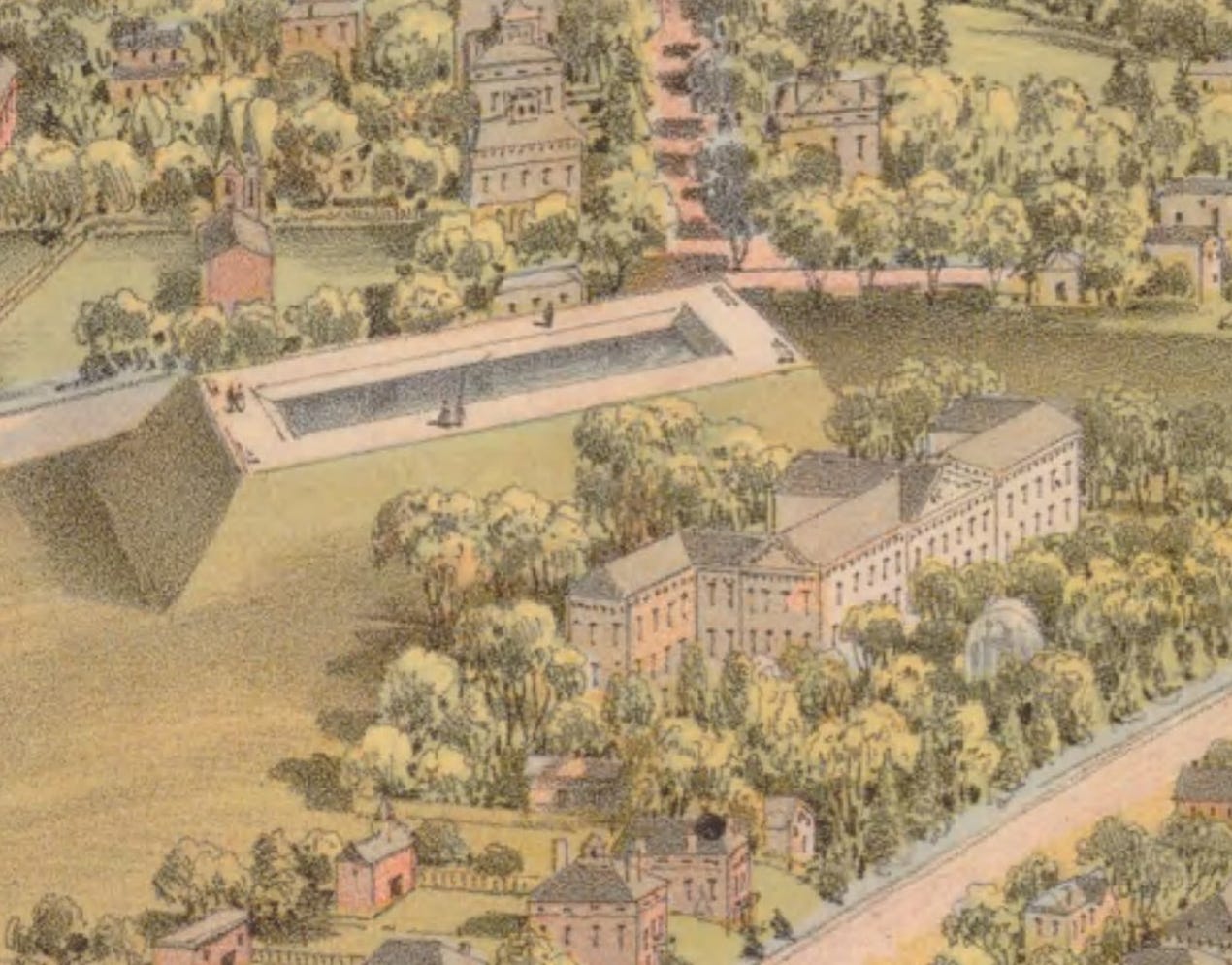Building the Garden Street Reservoir
Digging and filling up the city's first official municipal water supply

My latest YouTube video is about the lost Garden Street Reservoir, which existed from 1855 to 1920. It was located where there is now a parking lot, behind the headquarters of the Hartford Insurance Building on Asylum Avenue. A corner of the reservoir extended into the entrance of Cogswell Street, which was laid out after the reservoir had been removed. I feature a lot of interesting stories about the reservoir in the video, but here I want to share some details about the original construction of the reservoir in the late summer and early fall of 1855.
On December 20, 1853, the Hartford Courant reported:
We learn that the Water Commissioners have secured a site for the Reservoir, having concluded a bargain for the beautiful lot of Mr. Turner on Asylum Hill, and the lot adjoining on the South belonging to the Asylum. Mr. Turner's lot fronts about five hundred feet on Garden Street, and commands a view unsurpassed for beauty by any other location in the city. The sun to be paid Mr. Turner is $14,000—for the Asylum property, thirty-five dollars per foot on Garden Street. The elevation on Asylum Hill was found to be much greater than the localities talked of in the northern part of the city.
On March 29, 1854, the Courant reported that the city had awarded the contract for constructing the reservoir to James and Charles Collins of Brooklyn, New York, who had the lowest bid out of twenty-two proposals. Work on starting the reservoir was delayed that year because of a severe drought, but a little over a year later, on April 14, 1855, the Courant could report that,
About one hundred men, with thirty horses and carts are at present at work upon the reservoir.— Mr. Collins says that he hopes to have the reservoir finished by the latter part of July. It will be a very solid piece of work, having a good hard-pan foundation throughout and not likely to trouble the neighbors by the percolation. Push on the column gentlemen; for some of us are relying exclusively on you, for water, next summer.
Despite the Courant reporter’s exhortation, the reservoir would not be ready for the summer. Delay ensued owing to weather conditions, as the paper reported on July 16,
The reservoir on Asylum Hill progresses slowly. This year, we have had too much rain— last year we had not enough. The clay on the south east side has slid in a little, and the lining of stone will have to be relaid. At the north end, the bank is perfectly firm and the stone lining is handsomely laid. About the 1st of October, the water will be let on.
This new estimate for completion would also not be met as some of the banks continued to experience crumbling. The paper reported on August 24,
Rumors have been floating about town of much more serious damages having occurred to the reservoir on Asylum Hill, than the facts will warrant. The truth is that the clay bank on the west side, throughout a large portion of its line, has yielded to the pressure of the superincumbent mass, and slid in. The blue clay taken from the Kelsey farm, is as slippery as so much soap. Mr. Collins is now removing it along the base of the embankment, and intends to substitute the red gravel, which has more power of resistance. It will delay the works some weeks; but he confidently expects to finish the reservoir in the month of October, at the latest.— The money value of the damage to the reservoir by the slide, is from $2000 to $3000.
Unfortunately, an even worse collapse occurred over a month later, as the Courant reported on October 1,
The bank of clay, gravel and stone, along the whole eastern side of the Reservoir on Asylum Hill, slid in on Saturday night. The damage is similar, in its cause and its results, to what happened on the opposite side, some weeks back, but is much more extensive. The slippery blue clay from Kelsey's farm is the source of the trouble. We suppose the stone upon the whole eastern back will have to be relaid.
Two days later the paper revealed the steps that were undertaken to mitigate this more substantial collapse:
We understand the Commissioners on the Water Works intend to build a new wall, 8 feet inside of the old wall, on the northeast side, so as to save removing the clay and gravel in the old bank; and when they have carried their new wall some 6 feet above the bottom of the reservoir, they can commence pumping and supplying the city. This plan will make the reservoir more permanently secure, then any attempt to regain the line originally marked out, could possibly leave the reservoir.
Finally, on October 18, the Courant could report that the reservoir was ready. The pump house (or engine house) along the Connecticut River (which I show in my video) was about to be put into operation. There had been controversy at the end of 1854 about the steam engines to be used: the original engineer had ordered the standard Cornish engines from England, but after contentious debate he had been fired and in February 1855, the Board put in an order for a less expensive engine that was made right in Hartford by the Woodruff & Beach Iron Works.
We are informed by the contractor (Mr. Collins) that the Reservoir is now in a proper state to receive water. The rise in the River has prevented the completion of the pipes at the Engine House, but as soon as low water mark is seen the work will be resumed, and a few days will complete it. The steam engine and the pumping machinery at- tract much attention — the pumps move to the entire satisfaction of both the inventor and the builders; and the most sceptical [sic] will soon have ocular demonstration that HARTFORD can produce a pumping apparatus vastly superior, in every respect, to the antiquated old Cornish machine.
Our next report comes from November 6, 1855:
Yesterday afternoon there were 21/2 feet of water in the reservoir. It is calculated to hold 30 feet, or something over, if full to the brim; but the wall on the sides is not built up sufficiently to allow much more than its present contents to be pumped in. The pumps work to a marvel; even the particular friends of the Yankee Pumps are favorably disappointed in their operation. We trust but a few days will now elapse before our citizens are in the full fruition of that inestimable luxury, a plenty of pure soft water.

On December 6 the Courant reported on some finishing touches that would contribute to the reservoir’s recreational value:
The wall of the reservoir is now built up to its height, all around. The plan is, we understand, to sod down a border of about two feet, on the inside and outside of the top of the embankment, and have a broad gravel walk for foot passengers only between the borders. This will be a beautiful and doubtless a favorite promenade for all who wish to see the environs of the city or take a bite of pure air. The elevation must be at least 130 feet above the Connecticut.
In my video I give a number of examples of the ways in which the public utilized the Garden Street Reservoir as a park for about 65 years. On March 22, 1856, the Courant noted that the reservoir was finally finished, “except a light coat of gravel on the top and the covering of soil and sod, which the outside banks are to receive. The reservoir would continue to exist until it was finally demolished and filled in after the city sold it to the Hartford Insurance Company in 1919.
I’ll end this piece with one more quotation from the December 6, 1855 article quoted above:
At the river, the pier built out into the channel has been completed. A pipe has been carried some 30 feet outside the old wharf into the stream. — The bottom of this pipe is four feet below low water mark. There is a space of 20 feet between the inside of the pier and the wharf, left open for the passage of the muddy water in shore, and an eddy of dirty water is thus avoided. Our citizens get the best water that runs in Connecticut river; and get that only when the Connecticut is in good order. If the river gets high and turbid, there is a stop-cock in the pier which enables the engineer to shut the river out; and there is a screen, sliding in a groove from the top of the pier, that strains all the water that enters the pipe, at all times. The water flows from the river into the well by its own weight, merely. The suction pipe extends only to a well of 6 feet diameter, from which the water passes into the pumps.



